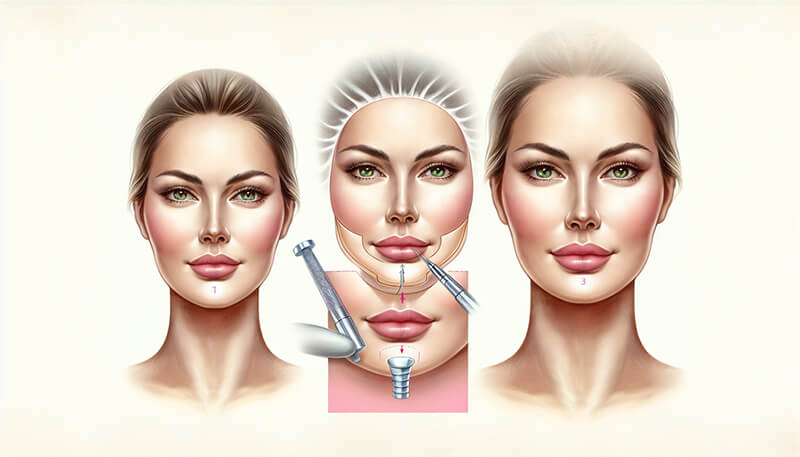













When it comes to looking younger, it's not just about the face. Have you thought about your neck and jawline, too? This blog dives into why these areas matter just as much and how they can create a beautifully balanced and youthful look. We'll explore different ways to enhance your neck and jawline alongside a traditional facelift, giving you the full scoop on achieving a refreshed and harmonious appearance.
Rhytidectomy, commonly referred to as facelift surgery, is aimed at reducing the appearance of aging on both the face and neck. The procedure focuses on creating natural-looking enhancements while keeping scarring and recovery time to a minimum, effectively rejuvenating the facial contour and neckline. It targets numerous symptoms of aging, such as folds between the nose and mouth, slackness in facial skin, loose skin around the neck area (often called "turkey neck"), and jowls.
With advancing age comes reduced elasticity of our skin, which leads to sagging as well as deep creases. Facelift surgery counteracts these effects by tightening both your skin and deeper tissue layers. It's an effective remedy for pronounced wrinkles along with drooping skin that accompanies loss of firmness over time. Women often notice these changes near their jaws or necklines more clearly due perhaps to hormonal fluctuations affecting their dermal elasticity.
Cutting-edge methods in rhytidectomy, such as liquid facelifts, mini-facelifts, or deep plane lift procedures, strive towards outcomes that avoid looking excessively tight—something traditional lifts are known for occasionally producing. Individualization during these surgeries involves choosing specific options regarding anesthesia use or where incisions will be made. It also might incorporate other aesthetic-enhancing operations like eyelid lifting or forehead elevations, ultimately achieving an overall youthful yet harmonious visage.
Neck lift procedures are a great way to tackle issues like sagging jowls, extra neck skin, and stubborn fat under the chin. These procedures can give you a more defined and youthful profile. Often done alongside facelifts, they help create a balanced rejuvenation for the face and neck.
A neck lift, also known as platysmaplasty, targets three main areas: excess fat, weakened neck muscles (the platysma), and loose skin. The process involves removing extra skin and fat while tightening the underlying muscles to significantly enhance your neck's contour. Small, discreet incisions are made under the chin or around the ears, and these are closed with absorbable stitches to minimize scarring.
Different techniques might be used during a neck lift, depending on your needs. Cervicoplasty reduces excess skin and tightens the layers beneath, while liposuction removes any remaining fat deposits. The incisions, made near the areas needing improvement, allow the surgeon to have full control over the transformation. After the procedure, there will be a healing phase where it's important to monitor any bruising. Over time, you'll see the aesthetic improvements as your recovery progresses, each patient's journey being unique and rewarding.
A neck lift, also known as platysmaplasty, is a surgical intervention designed to enhance the contour of the neck by eliminating surplus skin and fat. It addresses wrinkles and folds that come with aging, creating a smoother and more refined neckline. The process includes fortifying the platysma muscle, which tends to relax over time, leading to drooping skin.
In performing this surgery:
This helps reduce noticeable scarring while ensuring that the results look natural.
Neck lift surgery encompasses a variety of methods to address particular issues. For instance, cervicoplasty is aimed at excising excess skin and then tightening what's left to render the neck smoother and give it a rejuvenated shape—ideal for individuals with considerable sagging.
Liposuction is another technique used during neck lift procedures to target unwanted fat accumulation. It involves extracting fat from areas around the platysma muscle both above and below it, which helps to sculpt a more defined neckline and enhance jawline definition. When these surgical techniques are combined within one procedure, they effectively tackle several signs of aging in the neck simultaneously.
After undergoing neck lift surgery, patients can expect to experience:
It is critical for individuals to refrain from engaging in strenuous physical exertion or lifting heavy objects during the initial stages of healing following their surgery.
The incision marks resulting from a neck lift procedure could take up to one full year to fade significantly. Typically, these incisions are strategically placed so that they blend into the natural creases of the skin or are concealed behind the ears. Adhering strictly to the care instructions provided by your surgeon after your operation is vital for optimal results and for reducing any potential risks associated with complications.

Jawline fortification through jaw implants and rejuvenation practices delivers numerous advantages, including:
To conform to an individual's bone structure, these implants are typically constructed from substances that are compatible with human biology, such as silicone. During this procedure:
The implementation of jaw implant surgery yields improved uniformity across one's face, solidifies the appearance of one's jawline, and enhances harmony among all facial characteristics. Recovery often encompasses some degree of puffiness and sensitivity at the site. However, the majority of individuals can resume their usual routine roughly within seven days post-surgery.
Surgically positioned beneath the skin to augment the jawline's shape, jaw implants are customized rigid pieces crafted from materials like silicone. They align precisely with a patient's own jawbone for an enhancement that appears natural.
Often constructed out of substances such as Gore-Tex or silicone, these implants can amalgamate with organic body tissues and ultimately become incorporated into the body. The integration facilitates enduring results that improve the definition of the jawline and contribute to greater symmetry and balance within facial features.
Jaw implant surgery provides numerous advantages, such as enhancing the harmony of facial features and giving a more defined jawline. The procedure contributes to greater facial aesthetics by providing volume and refining the contour of the jawline.
The surgery positions the jawline into improved alignment with other features of the face, fostering a harmonious and rejuvenated look. It can diminish the presence of a double chin that may be due to an undersized chin bone, thereby boosting overall facial balance.
Healing from jaw implant surgery requires the mitigation of initial swelling and discomfort, which usually diminish within several weeks. Individuals who undergo this procedure are recommended to consume soft foods or liquids to promote the recovery process at the incision site inside their mouth.
The majority of individuals are able to resume work and routine activities approximately one week after surgery, though a complete healing period might extend beyond that time frame. Adherence to post-surgical care guidelines provided by the surgeon is crucial for ensuring seamless healing and achieving the best possible outcomes.

In pursuit of facial symmetry, procedures for chin enhancement are designed to refine an insufficiently developed chin or augment its definition. These interventions can dramatically alter the proportionality of facial elements, offering a visually pleasing outcome.
Crafted from substances such as silicone, chin implants serve to bolster both the form and volume of the chin. A surgeon typically inserts these devices via a small cut made underneath the chin or inside the oral cavity. This enables precise placement atop the bone structure beneath.
Undergoing surgery for a double-chin reduction augments harmony in one's visage accentuates jawline contours, and diminishes excess under-chin fullness. Prospective candidates must weigh potential complications like infection risks and sensation loss in their lower lip against these aesthetic advantages.
A chin implant, typically crafted from silicone, is designed to augment the contour and dimension of the chin by being placed beneath the skin. Meticulously shaped to conform to the jawbone's surface, this implant offers an improvement that appears entirely natural.
During this surgical procedure, a pocket is fashioned for accommodating the implant either through a small incision made underneath the chin or within the oral cavity. Following insertion of the implant into this space, sutures are used to secure closed at the site of surgery. Anesthesia administered before operation ensures that patients experience no discomfort throughout the process.
The surgical procedure of inserting a chin implant can significantly enhance facial balance, sharpen the contour of the jawline, and minimize the prominence of a double chin. The outcomes are enduring, with implants being tailored in size and form to suit each patient's unique requirements.
Nevertheless, it is crucial to be aware that this surgery may cause complications like numbness in the lower lip, infection risks, and displacement of the implant. To make a well-informed choice about undergoing this cosmetic procedure for your chin enhancement needs, ensure you speak with your surgeon regarding these potential risks during your consultation.
After undergoing chin implant surgery, it's important for patients to take time off to rest and refrain from any vigorous exercise, while also adhering strictly to the recovery instructions provided by their surgeon. Swelling and sensitivity in the chin area are common after-effects but usually diminish within seven days.
To help prevent infection and promote healing at the incision site, surgeons typically recommend using a specific antibacterial mouthwash. Though normal activities can be difficult, normal activities can be a challenge. Be resumed about ten days following surgery, it takes approximately three months for the final outcome of the procedure to become apparent.

Combining neck lifts, facelifts, and jawline enhancement procedures offers a cohesive solution for patients looking to rejuvenate their appearance. This integrated approach leads to satisfying results by creating symmetry across various facial features and restoring a balanced youthful look of the neck and face.
By integrating operations such as facelifts alongside eyelid surgery or brow lifts, one can effectively rejuvenate both the upper and lower regions of the face, promoting a harmonious and refreshed appearance. Combining facelift surgery with chin augmentation ensures that symmetry is enhanced across facial features.
Amalgamating these procedures allows for the administration of local anesthesia on just one occasion—this minimizes potential risks linked to repeated anesthesias while enhancing overall patient comfort. Tackling different elements of facial aging in a single surgical event enables patients to benefit from an easier recovery period while also extending the longevity of their youthful visage.
Creating a surgical plan customized to align with each patient's distinctive facial features and aesthetic aspirations is crucial for fulfilling their individual expectations. The surgery must take into account both their anatomical uniqueness and personal tastes to deliver the most pleasing outcomes.
Patients can attain a harmonious, natural appearance tailored to their particular requirements by collaborating with a board-certified plastic surgeon. This level of bespoke planning is essential for optimizing results in facial rejuvenation procedures, ensuring patients receive the finest care suited to them.
When several procedures are combined, the intricacy and potential for complications during surgery escalate. Multiple surgical sites implicated increase the chances of acquiring an infection.
It is not uncommon for combined procedures to marginally extend recovery periods. Adherence to all instructions after the operation is vital for a seamless healing process. Conversing with your surgeon about these possible complications prior to surgery can help establish realistic outcomes and prepare for various possibilities.
For individuals who are hesitant to pursue surgical methods but seek a youthful appearance, there exists an array of non-surgical procedures aimed at improving the neck and jawline. These techniques can serve as preventive measures against earlier surgery necessity or enhance the outcomes of previous surgeries while offering a minimally invasive path toward retaining a more youthful appearance.
Injectable substances like JUVÉDERM Voluma, Restylane Defyne, and Radiesse can enhance the jawline's prominence and definition. They achieve this by adding volume and improving its shape, offering instantaneous outcomes while also restoring jawline contours that have diminished due to bone loss or increased body weight.
For individuals with a distinct jawline experiencing a decrease in sharpness caused by potent neck muscles exerting downward pressure, Botox is an effective treatment option. The effects of Botox on the jawline last for about three to four months, whereas injectable fillers typically maintain their results for up to a year or more.
Non-surgical approaches such as laser therapy and radiofrequency treatments are efficient for enhancing the texture and firmness of the skin in the neck area, particularly around the jawline. The upper layer of skin is addressed by laser therapy, which aids in refining both its texture and tightness.
Radiofrequency therapy targets deep within the skin layers to boost collagen formation, leading to a more tightened and firm appearance. Morpheus8 utilizes a fusion of microneedling with radiofrequency energy, effectively addressing issues like loose skin, minor wrinkles, and uneven pigmentation.
Utilizing ultrasound energy, treatments like Ultherapy are designed to penetrate the deeper layers of tissue, promoting the generation of collagen and elastin. The result is a lift that effectively tightens skin. This method presents a non-surgical avenue for improving the appearance of the neck and jawline.
These ultrasound procedures deliver gentle but perceptible enhancements, positioning them as an ideal selection for individuals aiming to refine their look without resorting to surgery. Depending on each person's unique skin characteristics and aging trajectory, the effects of these treatments can be sustained over many months.
Choosing an adept surgeon is crucial for achieving the best outcomes in facial rejuvenation. Ensuring that your plastic surgeon is board-certified and specialized in facial procedures guarantees their proficiency and experience, positioning you to receive exceptional care.
To become a board-certified plastic surgeon, one must complete extensive training and specialized education in reconstructive and cosmetic surgery after graduation from a recognized medical institution. Securing certification from either the American Board of Plastic Surgery or the Royal College of Physicians and Surgeons of Canada ensures that stringent criteria have been fulfilled.
When surgeons who lack certification by the American Board of Plastic Surgery carry out these procedures, there's an increased risk of complications. This certification confirms that the surgeon has undergone comprehensive training and abides by elevated standards that promote patient safety and excellent surgical results.
During the consultation, it is imperative to converse about your physical health, medical history, and anticipated outcomes of the surgery. It's essential to confirm whether the surgeon holds certification from the American Board of Plastic Definitive Surgery.
You should inquire regarding any possible complications and additional procedures that may be suggested to gain a thorough knowledge of what lies ahead. Engaging in this dialogue will assist you in making an educated choice and prepare you for both the procedure and the recuperation phase.
Reviewing pre- and post-operative images is essential for evaluating a surgeon's proficiency and reliability in delivering the anticipated results. Search for pictures of individuals with facial features similar to yours to more accurately predict possible results.
Perusing these photographs can assist you with several aspects:
Attaining a youthful appearance can often necessitate an all-encompassing strategy that extends beyond the scope of conventional facelift techniques. Procedures aimed at improving the neck and jawline, including but not limited to neck lifts, chin enhancements, and jaw implants, can offer comprehensive rejuvenation that brings balance and harmony.
There is a spectrum of surgical and non-surgical methods to combat the signs of aging on one's face. This variety enables tailored treatment approaches aligned with each person's unique aesthetic desires. It is essential for optimal outcomes and guaranteed safety that individuals seek out a surgeon who possesses both qualifications and experience in this field.
Adopting progressive procedures targeting improvements in the neckline and chin area significantly enhances overall facial allure. Find a Beverly Hills plastic surgeon with board certification who can help you consider which avenues best suit your aesthetic needs.
Depending on the patient's wishes and the surgeon's expertise, chin implants can produce results that range from modest enhancements to significant alterations in appearance.
Following chin implant surgery, patients must undergo a recovery phase that includes taking one week off for rest, refraining from intense physical activities, consuming only soft food items, utilizing a compression garment for support, and ensuring they sleep on their backs with their heads raised. It takes approximately three months after the procedure to observe the complete outcomes of the surgery.
A platysmaplasty is a procedure carried out through surgery to correct slender vertical bands in the neck by reinforcing and realigning the platysma muscle. This surgical process includes suturing the edges of this muscle together and securing it more robustly to surrounding structures within the neck.
Surgery to implant a chin provides substantial satisfaction for patients, harmonizes the proportions of facial features, accentuates the jawline, and diminishes the appearance of a double chin. The tailored nature of the implant, use of local anesthesia during surgery, scars that remain invisible, and enduring outcomes contribute to its attractiveness as a surgical option. If necessary or preferred by the patient in future considerations, these implants can be removed with relative ease.
You may contemplate several procedures to improve the chin and jawline, including neck lift surgery, facelift, injectable fillers, chin liposuction, mandibular advancement surgery (sliding genioplasty), and orthognathic surgery. Orthognathic surgery is frequently utilized for this objective.